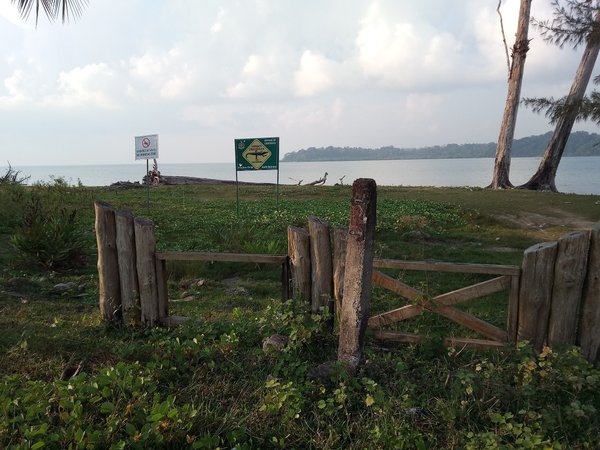
When I open my eyes, it’s still dark outside. I reach for my phone but hesitate before switching it on. Would the light from the phone show me cockroaches clinging to the mosquito net over my bed? Would I see rats eating their way through my backpack as they had eaten through the belongings of so many others who came before me? Or perhaps I would find the famed Andaman pit viper or Andaman cobra that had slithered into the traditional Karen hut I was living in, which, charming as it seemed, provided little protection from unwanted intruders?
I shudder at the thought and decide that bathroom activities and chai would have to wait until dawn when I can see everything in front of me. Not for the first time during my visit to the field station of the conservation organisation I worked with in the Andaman Islands did I wonder what a city girl like me was doing amidst such ‘rustic’ settings. Sure, I had done rural field visits before but they had mostly been to cover anti-trafficking work in small towns and villages in India. For the most part though, ‘roughing it’ did not involve so much proximity to wildlife and hours-long discussions on reptile or avian taxonomy and ecology. And, unlike the researchers who enthusiastically spent most of the year at the Andaman field station or in even remoter places searching for anything that crawled, slithered or flew, my brief stint in the Andamans was for a communications assignment. I had naively thought that it would be more people-oriented with occasional interaction with the Islands’ charismatic megafauna instead of me being frequently terrified by my inability to keep bugs and reptiles at bay.
Looking out of the plane taking me to Port Blair, I had felt the thrill of excitement and adventure that I was sure lay ahead. Conservationists work in gorgeous settings; I had heard that the Andaman Islands, with its rainforest vegetation, warmly humid, salty sea air, aquamarine waters, and sparsely crowded roads, was a tourist paradise to rival with. Though the islands are increasingly becoming prime tourist destinations, there are still many areas that retain their endemic and invasive flora and fauna. The social scientist in me was keen to discuss the intersections of the ecological, political and social implications of the ecologists’ findings and relay what I had learnt to a broader audience. All this set against the backdrop of the crystal-clear waters and sandy shores of their field sites, of course, or perhaps after a day of scuba diving to see first-hand some of the marine life and coral reefs being researched.
Instead, I tread slowly towards the bathroom that is a few metres away from my hut, side-stepping the crustacean hermit crabs who are either sleeping or pretending that they are simply empty shells. My colleagues have cheerfully told me of their many close-call experiences with snakes, each colleague competing with the other as they list the different species of snakes that they have found in innocuous places around the field station (the bathrooms seem to be a clear winner). I am eager not to have a similar experience. My numerous encounters in the bathroom with spiders as big as the size of my palm alone have made me feel akin to Frodo and Sam stepping into Shelob’s lair.
A little later, I head to the dining area hoping that breakfast is ready. As I sip my chai and stare at the calming landscape in front of me, my thoughts are interrupted by excited voices approaching the dining area. It’s the avid birdwatchers who had gone birding at 5am. I am amazed by how much they know and how they can identify birds not just from their feathers and size but also from listening to bird calls. I wonder what they would think if I told them that I cannot differentiate between an eagle and a kite, that I thought a warbler was an object and that I had not heard of a drongo!
I spend the rest of the day talking to my colleagues, almost all of whom are natural scientists, about their research on turtles, sharks, rays, fish and fishing practices, bullfrogs, crocodiles, trees…the list goes on! Some of what I can understand is fascinating. Who knew that the sex of turtles and crocodiles is temperature-dependent (TSD) or that the Indian bullfrog is an invasive species in the Andamans because tadpoles of bullfrogs had been imported from the mainland by those mistaking them to be juvenile fish!
Some of what they say goes over my head. It’s as though they are speaking a secret language known only to themselves. I nod along, making mental notes to google what they’ve said when I get a chance. Although I have a background in political and social sciences, I’m quite sure they don’t expect me to understand their work. I was frequently asked by my natural scientist colleagues, ‘Is social science even a real science?’
At the end of the day, with my head dizzy with so much of information and so many unsolicited, heart-stopping, near-wildlife encounters, I decide to head to the beach just a short distance away. I grew up near the sea and beaches have always helped me de-stress. Maybe I can dip my feet in the sea or sit on the beach and read a book while watching the sun set. Maybe my phone will even catch signal and I can check my messages.
Smiling happily, I approach the entrance to the beach with the eager anticipation of finally having some down-time. That’s when I see the board placed near the entrance.
‘Danger. Crocodiles. No swimming.’
Tanya Koshy is a sustainable development and social justice professional who has worked in the fields of human trafficking, refugee and asylum claims, conservation, sustainable livelihoods, education, and human rights.
15 August 2021